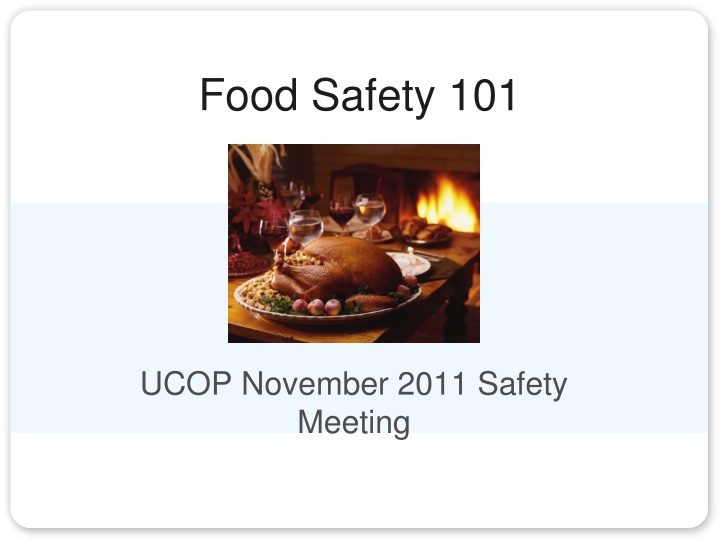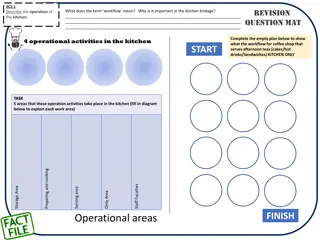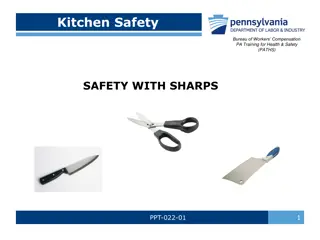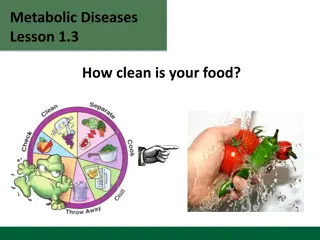Essential Food Safety Guidelines for a Healthy Kitchen
Learn crucial food safety practices to prevent foodborne illnesses, such as washing hands thoroughly, cleaning and sanitizing utensils, maintaining proper food temperatures, limiting exposure to room temperature, and safe turkey handling tips. Follow these guidelines to ensure the safety of the food you prepare and consume.
Download Presentation

Please find below an Image/Link to download the presentation.
The content on the website is provided AS IS for your information and personal use only. It may not be sold, licensed, or shared on other websites without obtaining consent from the author.If you encounter any issues during the download, it is possible that the publisher has removed the file from their server.
You are allowed to download the files provided on this website for personal or commercial use, subject to the condition that they are used lawfully. All files are the property of their respective owners.
The content on the website is provided AS IS for your information and personal use only. It may not be sold, licensed, or shared on other websites without obtaining consent from the author.
E N D
Presentation Transcript
Food Safety 101 UCOP November 2011 Safety Meeting
Foodborne Illness Flu-like symptoms: Nausea Vomiting Diarrhea Fever Caused by Bacteria or other pathogens in food
Wash Those Hands! Soap and Warm Water Rub for 15-20 Secs. Remember to wash under finger nails, between fingers and exposed portions of wrists and arms Rinse & Dry with Paper Towels Wash Hands Again After Any Act of Contamination
Clean and Sanitize Use Clean & Sanitized Equipment & Utensils When Preparing Food Use Wipes After Washing & Rinsing for Optimal Effectiveness
Keep Hot Foods Above ___oF 57 oF 100 oF 120 oF 135 oF Use Food Probe Thermometer to Ensure: Raw Poultry is Cooked to At Least 165oF Ground Beef is Cooked to At Least 155oF Pork, Fish, Steak, and Eggs are Cooked to At Least 145oF
Keep Cold Foods Below ___oF 60 oF 51 oF 41 oF 25 oF Cool Hot Food Rapidly From 135oF to 41oF within 4 Hours By: Dividing into Smaller Portions; Placing into Shallow Containers Add Ice as an Ingredient and/or Frequent Stirring Refrigerate
Limit time food is exposed to Room Temperature to: Less than 6 hours Less than 4 hours Less than 2 hours Discard Food Left Out Beyond the 4-Hour. Dairy products, eggs, and mayonnaise should be kept at room temperature a maximum of 2 hours.
Lets Talk Turkey!! Thawing Frozen 24 Hours for Every 4-5 Pounds (In Refrigerator 40oF or Below) Oven Temperature No Lower Than 325oF Cooked to 165oF Internal Temperature Innermost Part of Thigh & Wing and Thickest Part of the Breast Refrigerate Leftovers within 2 Hours Use Gravy within 1 to 2 Days Use Turkey & Stuffing within 3 to 4 Days
In Case of Suspected Foodborne Illness Preserve the evidence Seek treatment as necessary Contact local Health Department Contact the USDA Meat & Poultry Hotline at: 1-888-MPHotline e-mail Address: mphotline.fsis@usda.gov























